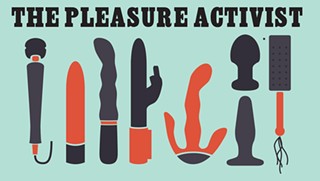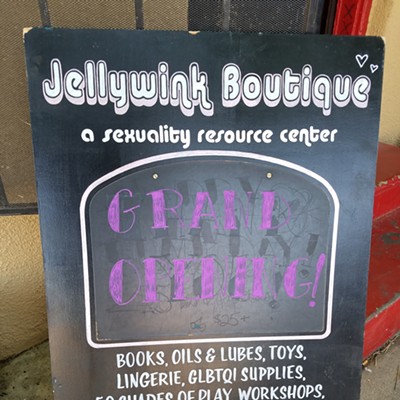Have you, or anyone you know, experienced a painful stinging or burning sensation as a result of using a crappy rubber jelly type dildo? You're not the only one. People walk through my shop, wave broadly at a wall of dildos and declare that they are allergic to them. This would be like to walking into a grocery store and saying that you are allergic to food, when you are only allergic to peanuts. Not all sex toy materials are created equal.
A couple ingredients are the main culprits when it comes to causing bad reactions. However, just because you are not experiencing any "symptoms", it is still wise to avoid toxic ingredients, as they are likely still affecting you.
Latex is a natural and non-toxic ingredient, but many people have developed allergies to it due to over-exposure. Not too many toys contain latex these days, and latex-free condoms are available.
Phthalates, on the other hand, are a pretty toxic plastic softener used in many of the non-silicone rubber blends. They have been associated with endocrine disruption, breast cancer, and are potentially harmful for prenatal development. Even many of the lower-quality sex toy companies have now stopped using this ingredient due to the increase of consumer awareness. However, one must be skeptical of packaging that simply states "phthalate-free" if it is not a reliable company in the first place. Many companies engineer new ingredients by moving around a molecule here or there and then naming it something else until people discover that this ingredient, too, is toxic.
You can avoid these ingredients by sticking to clean materials and purchasing from trustworthy manufactures or shops. If one dildo costs five times the cost of another, there is usually a good reason for this—but there are exceptions!
Pure silicone, borosilicate glass, and stainless steel are a few examples of clean body-safe sex toy materials, but there are a few others, as well.
Silicone (Pure Medical Grade)
Many people assume silicone is synonymous with every other rubbery material out there. That would be like putting apples and Twinkies in the same category. Pure silicone is non-porous, and therefore easy to clean and sterilize. Not only will it not absorb and harbor bacteria, but you can boil it or throw it in the dishwasher. Basically, you can light it on fire and it won't melt. People bake with silicone. It is inert. This means that it does not leach any chemicals and has no scent. Pure silicone toys can last you a lifetime and will basically look the same after decades (unless your dog has used it as a chew toy).
There are different densities of silicone from firm to squishy, and some toys have dual densities—a firm core with a softer exterior—in order to simulate the realistic feeling of an erect penis. Needless to say, these dildos are the priciest, but worth every inch!
Just like the fast food industry is allowed to call something "meat" when only maybe 15 percent of the "meat" is actually meat, toy companies can call something "silicone" when in fact it is a rubber blend. You can avoid this pitfall by making sure the label says "100 percent silicone" or "medical-grade silicone," or buying from a trustworthy manufacturer, or consulting your friendly neighborhood sexuality educator (hint, hint!). Some telltale signs that it is not silicone: Does it smell like anything? Rubber? Chemicals? Flowers? Then it's NOT silicone. Is it clear/transparent? Then it's NOT silicone. Did it melt when you stored it with your other rubber toys? NOT silicone.
Glass (Borosilicate/Pyrex) & Stainless Steel
Some people express uneasiness when they see glass toys on my shelves. That instinct is well founded, generally speaking. However, reputable glass toys are borosilicate (Pyrex) glass. They can easily withstand freezing and heating without breaking, and if thrown across the room against a cement wall (for those really dramatic moments), they won't shatter into tiny little pieces. (If you are buying directly from a glass blower, make sure they are using borosilicate glass. Many artisans will sell glass "sex toys" that are NOT safe to use. So ask them.)
In any case, our delicate human tissues are not strong enough to break glass, so no worries! The advantages are that they are deliciously smooth and firm (better for internal massaging rather than vigorous thrusting), they absorb temperature beautifully, require barely any lube, are sterilizable, and aesthetically pleasing.
Stainless steel has many similar advantages of glass but has a heavier feel. Again, be wary of marketing. Many "steel" toys are hollow and chromed rather than being a solid piece of stainless steel. While one can save money with these hollow toys, they are also susceptible to chipping and cracking.
Ally Booker is a pleasure activist, passionate about educating herself and others on sexuality, communication skills, creating and respecting boundaries, sexual self-determination, destigmatization, gender and sexual expressions, sex toy use and all the other mechanics of pleasure. You can often find her at her Tucson shop, Jellywink Boutique, 418 E. 7th St.





